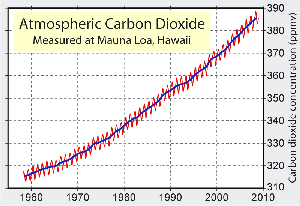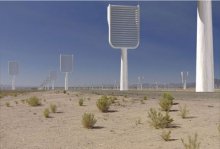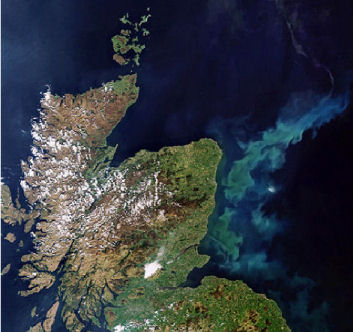
Updated 18 November 2010

|
Updated 18 November 2010 |
|
HOME PAGES GLOBAL WARMING WHAT YOU CAN DO GREEN ISSUES BACKGROUND THE INITIATIVE |
Schemes to Counter Global Warming Geo-engineering is a general term for all kinds of interventions with natural processes, typically to counter the effects of the increasing concentration of greenhouse gases in the atmosphere. One general method seeks to extract carbon dioxide from the atmosphere, for example by: A second approach attempts to reduce solar radiation, typically by:
A third option is Arctic geo-engineering, which attempts to retain the sea ice in the Arctic. Any attempt to influence the weather on a global scale raises international diplomatic and legal issues. * Many of these options may have unforeseen serious side effects, and would not be reversible. None of them deals with all of the problems to be tackled. 
Schemes for deliberately altering the world's natural systems are called geo-engineering. They are being investigated partly because of the widespread belief that the world cannot move fast enough to achieve the dramatic changes necessary to avoid a terrible disaster. This is illustrated by the fact that CO2 has continued to increase steadily in the atmosphere in spite of the Kyoto agreement. A false hope that there is a technical fix through geo-engineering may weaken the essential drive to cut back on emissions. Shading the sun The schemes depending on reducing the heat collected from the sun raise additional concerns:
The best that can be hoped for from modifying the solar heating is that one of these schemes might delay global warming by 20 years. If during these 20 years the necessary actions to reduce emissions are delayed, the long-term effects are likely to be worse than if the schemes had not been implemented, while the chosen action would have to be continued for hundreds of years. Projects that remove carbon from the air and put it into suitable long term storage are the more benign forms of geo-engineering. They can be implemented in one country without potentially harmful effects on other countries. They also counter all the effects of having increasing concentrations of CO2 in the air, not just the effect of global warming. The most direct form of geo-engineering is to extract the CO2 and other greenhouse gases from the air, to compensate for the generation of these gases elsewhere. This is similar to the proposals to capture the CO2 from power stations, however extraction from the air can counter the increase of CO2 from any source. 
The process has the disadvantage that it is trying to extract a gas which is only about 0.04% the air being treated. On the other hand it is not necessary to remove the majority of the CO2 as any CO2 removed is a benefit. Another advantage is that the extraction can take place close to where the CO2 is to be stored, avoiding transport costs. If a plant generating CO2 was linked with a plant somewhere else which was extracting CO2 from the air, it would be possible for the combined enterprise to remove 100% or even 120% of the CO2 generated. The method of capturing the CO2 cannot afford to use a fan or any other device that uses significant energy, so it will probably use the wind to bring the air in contact with a chemical process to capture the CO2. A separate process is then likely to be used to extract the CO2 for storage. Such a carbon extraction installation might be compared with a wind turbine generating electricity from the same wind. An ideally efficient wind turbine of 1 square metre crosssection facing a wind of 8 metres/second can generate about 0.33 kW. If this replaced electrical power generating 430 gm of CO2 per kWh the wind turbine saves about 140 gm of CO2 per hour. In the same time about 14,000 grams of CO2 would pass in the air, so a CO2 extraction plant only has to remove about 1% of the CO2 from the air to have the same overall reduction in atmospheric CO2. The CO2 extracted from the air must be permanently stored. Current plans concentrate on placing it in oil and gas reservoirs, unmineable coal seams, deep in the earth and in deep saline reservoirs in the oceans. * Carbon dioxide air capture appears to be the most benign form of geo-engineering. The subject is explored in more detail in a paper from the US National Energy Technology Laboratory – Capturing Carbon Dioxide From Air. 
Biochar, a carbon-rich material, is produced by burning waste organic material in a reduced oxygen environment. The traditional biochar was charcoal produced from wood. Biochar has for millennia been used to add to soils to increase their productivity. Plants naturally take CO2 from the air to grow. If carbon in plants can be buried it has been taken out of the atmosphere. It is normally buried as biochar since untreated plant material will rot and give off methane. If agricultural land is used to grow plants specifically for this process, the land available for growing food reduces, causing increasing difficulty in feeding the world's population. The use of land for biofuels is believed to have been a factor in recent food price rises. * However, if the natural wastes from food production, such as straw, could be sequestered as biochar, it would have a useful effect. 
Plankton comprise the collection of small drifting organisms which are at the bottom of the food chain. Much of the plankton are minute plants, and as with land plants they capture carbon. In some parts of the oceans and at some times of the year plankton gather in enormous numbers in a bloom, which can colour the sea. Most of the plankton are eaten and eventually the carbon is recycled, but a small proportion grow minute shells which can drop to the floor of the ocean, where deposits of calcium carbonate can accumulate. This leads to the idea that if an intervention encouraged more plankton blooms, more carbon might be deposited at the bottom of the sea. There are areas of the ocean which appear to have suitable nutrients but which do not generate plankton blooms. One reason is the absence of trace quantities of iron, and it has been found possible to trigger plankton blooms by adding small quantities of fine iron particles to the surface. It has been calculated that the eruption of Mount Pinatubo deposited approximately 40,000 tonnes of iron dust into the oceans worldwide. There was an associated impact in the direction of lowering atmospheric CO2 and increasing in oxygen levels – though most of this will be a temporary effect while the bloom lasts. In a controversial experiment in 2008, a 30x30 kilometre patch of ocean was seeded with 6 tonnes of iron sulphate. A large bloom was triggered, however this bloom did not contain many of the slightly larger animals with shells, probably because the fertilized location was depleted in silicic acid, an essential nutrient for their growth. As a result a relatively small amount of carbon was sequestered. * Interfering with the natural processes of the ocean would seem to be risky, particularly as this approach is unlikely to be very effective in removing carbon from the atmosphere. The effect of greenhouse gases is to increase the solar heating of the earth. The effect of the current and expected increases in greenhouse gases is equivalent to an increase in the heat from the sun of a few percent. Thus if the heat from the sun could be reduced by the same percentage, this should cancel the heating effect of the greenhouse gases. This would not alter the other effects of increased greenhouse gases such as the acidification of the oceans. There is a place between the earth and the sun, known as the Lagrange L1 point, where the combination of the gravitational attraction of these two bodies will keep objects orbiting the sun in approximately the same position. If objects can be placed in this location to shield the earth from the sun this would reduce the sun's energy reaching the earth. The total area of such a sunshade required to make a difference is naturally a few percent of the cross-section of the earth, or several million square kilometres. One scheme proposed by Roger Angel at the US National Academy of Sciences in April, 2006 involves firing billions of minute reflectors into space using a large rail gun or coil gun. It seems unlikely that the reflectors can be kept at the Lagrange L1 point for very long, as the point is one of unstable equilibrium. If we assume that they arrive at the point with a typical residual velocity of only 1 metre per second they will have moved the diameter of the earth in 5 months. If a barrage of small particles is maintained to keep the shield in place they will spread out and many would orbit between the earth and the sun. If in future this was found to have a detrimental effect there would be nothing that could be done about it. An alternative would be to deploy many spacecraft in orbit around the earth, each with a large mirrored surface. It would seem unlikely that we could maintain enough spacecraft in orbit to cover 1% of the sky without frequent accidents in which they crashed into each other, and the resulting build-up of space debris would bring the whole exercise to a halt. * The idea of a space sunshade does not seem to be viable.
Cloud reflectivity enhancement 
If clouds are seeded with salt they become whiter, and reflect more sunlight. One suggestion is to employ fleets of ships blowing sea water skywards in areas where there is often suitable cloud cover. These areas are off the west coast of North America, off the west coast of South America and off the west coast of South Africa. Testing this scheme with a computer model for the climate indicated that it did reduce global temperatures but that the effects are uneven, for example it was likely to increase rainfall significantly in India and reduce it in the Brazilian rain forests. 
Steven Chu, the US Secretary of Energy and a Nobel prize-winning scientist, suggested making roofs and pavements white or light-coloured to help to reduce global warming. This was only partly because of its effect of reflecting sunlight back into space. The other effect was to reduce the heat absorbed by the building and thus to reduce the energy used for air conditioning. This is particularly relevant to hot climates. The direct effect of painting all roofs and roads in light colours would be limited, as to have a significant effect it would be necessary to change the reflections from at least 1% of the earth's surface, and human structures occupy less than 0.1% at present. 
The effect of global warming on the Arctic is of particular concern. See the discussion under global warming. The temperature in the Arctic is rising faster than elsewhere, leading to more of the ice coverage disappearing in summer. This exposes the sea, which then absorbs more of the heat of the sun than the ice, amplifying the effect both for the Arctic and the world. There is also concern that as the Arctic warms methane will be released from the permafrost on its shores. Methane is a much more potent greenhouse gas than CO2 and would add to global warming. It thus seems possible that specific action on the Arctic might be appropriate and easier to get agreement for. The method would be to spray water onto the surface of the ice. Water is more likely to freeze on the top surface than the bottom, because of the insulating effect of the ice. This would of course be a massive and very difficult undertaking trying to stabilise as much as 5 million square kilometres of ice. Any scheme involving geo-engineering is likely to affect more than one country and may involve use of a shared resource such as the sea. This is particularly true of the schemes to reduce solar radiation. However even the schemes to take CO2 from the air can raise legal and diplomatic issues if, for example, it is planned to store the CO2 in the ocean. It is unclear how it would be possible to get diplomatic agreement on these issues, particularly if some countries are to be adversely affected. There is a danger that commercial interests may start one of the less desirable geo-engineering projects, such as seeding the oceans with iron or growing crops for biochar, paid for by carbon offset contributions. |
 |
If you have any comments or queries about this website please contact the
webmaster. |
© Blewbury Energy Initiative 2014 |